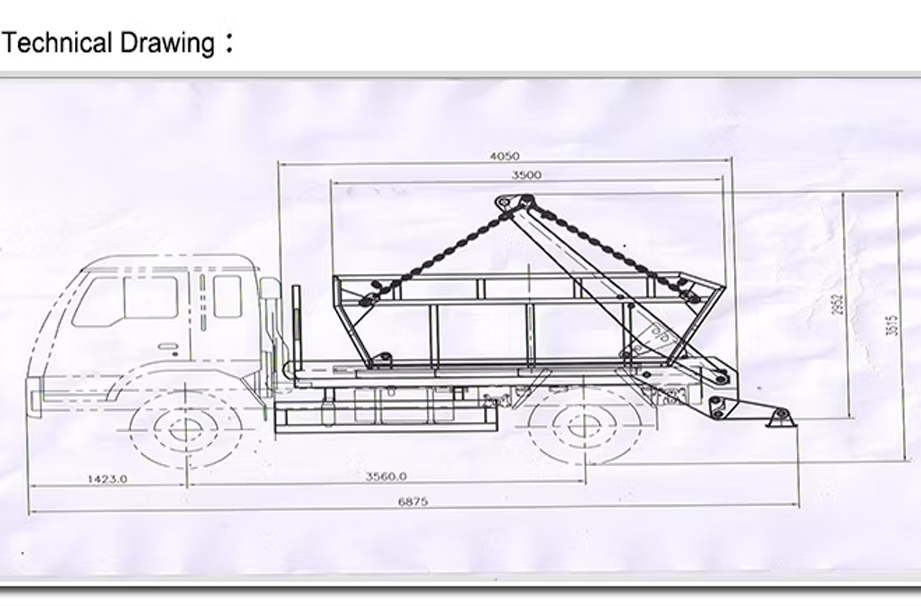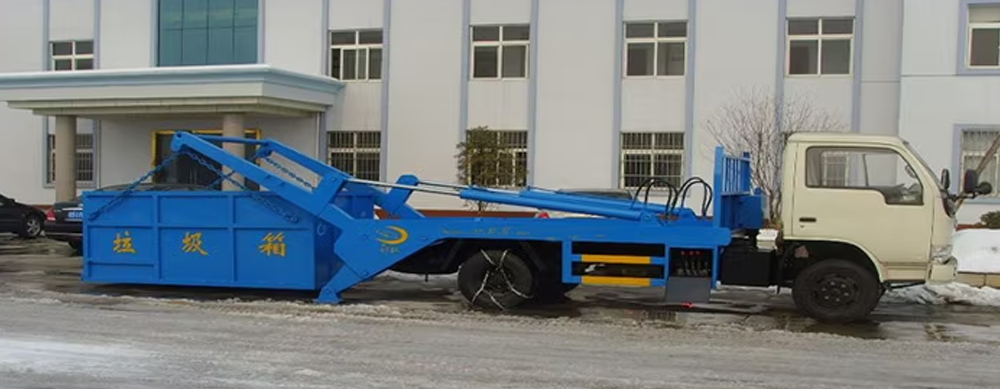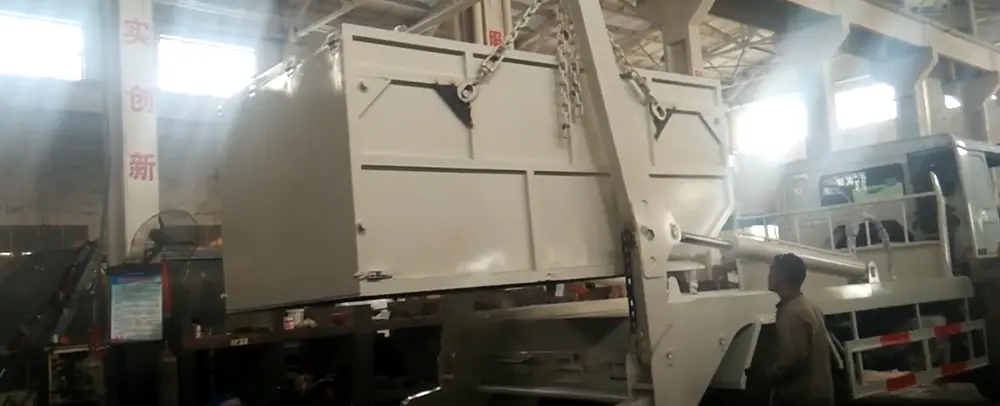A Swing Arm Garbage Truck is a specialized waste collection vehicle. It is built on a solid chassis, usually made of heavy-duty steel, providing a stable platform. The unique swing arm mechanism is its key feature. This arm, which is often hydraulically powered, can swing out to pick up waste containers from the side of the road and deposit the contents into the truck's cargo area.
The cargo compartment is designed to hold a significant amount of waste and is made of corrosion-resistant materials. The cab is crafted for driver comfort, with ergonomic seats and a clear instrument panel. It also has safety features like bright lights and warning signals. This type of truck is suitable for areas where waste containers are located along the roadside. It offers efficient waste collection, reducing manual labor and enhancing the overall waste management process.
| TEM | UNIT | PARAMETER |
| Vehicle | Swept body garbage truck | |
| Overall dimensions | mm | 5995x1880x2150 |
| Tank volume | m3 | 5 |
| GVW | kg | Appro×5500 |
| Curb weight | Appro×3000 | |
| Payload | Appro×5500 | |
| Wheel base | mm | 3360 |
| Suspension | 1250/2400 | |
| F/R track base | 1940/1860 | |
| Approach/departure angle | ° | 25/21 |
| Max speed | km/h | 95 |
| Axle Load | kg | 2.5/3 |
| Tire specification | 7.00-15 / 7 Units | |
| Number of axles | 2 | |
| Engine model | 4JB1CN | Diesel, 4 Cylinder, direct line, water cooling |
| Engine performance | ml/kw | 2700/72 |
| Transmission | 5 speed with over drive, 5F&1R | |
| Cab passenger | 3 | |
| Electric System | 24V | |
| Tank material | Carbon steel, side thickness 3mm, botton thickness 4mm | |
| Standard configuration | 1. Hydraulic system powered by trucks chassis PTO 2. Body with rear lifting system to handle garbage containers capacity 10m3 3. Body painted 1 coat anti-corrosion primer and 2 coats synthetic paint | |

1. The chassis of a Swing Arm Garbage Truck is a heavy-duty structure, typically made of high-strength steel plates. It serves as the fundamental support for the entire vehicle.
2. The swing arm mechanism is the core component of this type of garbage truck. It is usually made of strong, durable steel. The arm is powered by a hydraulic system that provides the force to swing the arm outwards and inwards.
3. The cargo compartment is where the waste is stored. It is typically made of corrosion-resistant materials such as stainless steel or high-density polyethylene. The size and capacity of the compartment vary depending on the specific requirements of the waste collection operation.
4. The hydraulic system is a crucial part of the swing arm garbage truck as it powers the swing arm mechanism. It includes a hydraulic pump, which is usually driven by the truck's engine through a power take-off (PTO) system.
5. The cab is designed with the driver's comfort and functionality in mind. It features an ergonomic seat to reduce fatigue during long working hours. The controls for driving the truck and operating the swing arm mechanism are laid out in an intuitive manner.
6. Swing Arm Garbage Trucks are equipped with a range of lights and safety equipment. There are bright headlights and taillights for visibility during nighttime driving and transportation.

1. Lifting Capacity: Determine the maximum weight of waste containers the swing arm can handle. This is crucial as it affects the types of containers you can collect.
2. Reach and Flexibility: The reach of the swing arm should cover the area where waste containers are placed.
3. Capacity: Estimate the volume of waste you need to collect regularly. The cargo compartment's capacity should be sufficient to reduce the number of trips to the disposal site.
4. Material and Durability: The compartment should be made of durable, corrosion-resistant materials. Stainless steel or high-density polyethylene are common choices.
5. Power and Speed: The hydraulic system that powers the swing arm needs to be powerful enough to operate the arm smoothly and quickly.
6. Reliability and Maintenance: Opt for a hydraulic system known for its reliability. Fewer moving parts and easy-to-maintain components reduce the risk of breakdowns.
7. Chassis Strength: The chassis must be strong enough to support the weight of the cargo compartment when full and the forces exerted by the swing arm.
8. Suspension and Tires: A good suspension system absorbs shocks and vibrations, providing a comfortable ride and protecting the truck's components.

The swing arm mechanism is the most distinctive feature. Made of strong steel, it's powered by a hydraulic system. Hydraulic cylinders control the arm's movement, allowing it to swing out and in with precision.
The chassis is a heavy-duty structure, crafted from high-strength steel. It serves as a solid base to support the weight of the cargo compartment, the swing arm, and the waste. Reinforced axles ensure an even distribution of the load.
The cargo compartment is designed to store a significant amount of waste. It's usually made of corrosion-resistant materials like stainless steel or high-density polyethylene.
The hydraulic system is vital for operating the swing arm. It consists of a hydraulic pump, typically driven by the truck's engine through a power take-off (PTO) system.
The cab is designed with the driver's comfort and ease of operation in mind. It has an ergonomic seat to reduce fatigue during long working hours. The controls for driving the truck and operating the swing arm mechanism are laid out in an intuitive manner.
The truck is equipped with safety and visibility features. It has bright headlights and taillights for clear visibility during nighttime driving. Reflective markings on the sides and rear of the truck enhance its visibility in low-light conditions or when other vehicles' headlights shine on it.

